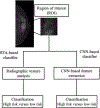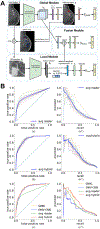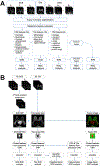Clinical Artificial Intelligence Applications: Breast Imaging
- PMID: 34689871
- PMCID: PMC9075017
- DOI: 10.1016/j.rcl.2021.07.010
Clinical Artificial Intelligence Applications: Breast Imaging
Abstract
This article gives a brief overview of the development of artificial intelligence in clinical breast imaging. For multiple decades, artificial intelligence (AI) methods have been developed and translated for breast imaging tasks such as detection, diagnosis, and assessing response to therapy. As imaging modalities arise to support breast cancer screening programs and diagnostic examinations, including full-field digital mammography, breast tomosynthesis, ultrasound, and MRI, AI techniques parallel the efforts with more complex algorithms, faster computers, and larger data sets. AI methods include human-engineered radiomics algorithms and deep learning methods. Examples of these AI-supported clinical tasks are given along with commentary on the future.
Keywords: Breast cancer; Computer-aided diagnosis; Deep learning; Diagnosis; Machine learning; Medical imaging; Screening; Treatment response.
Copyright © 2021 Elsevier Inc. All rights reserved.
Conflict of interest statement
Disclosure Q.Hu declares no competing interests. M.L. Giger is a stockholder in R2 technology/Hologic and QView; receives royalties from Hologic, GE Medical Systems, MEDIAN Technologies, Riverain Medical, Mitsubishi, and Toshiba; and is a cofounder of Quantitative Insights (now Qlarity Imaging). Following the University of Chicago Conflict of Interest Policy, the investigators disclose publicly actual or potential significant financial interest that would reasonably appear to be directly and significantly affected by the research activities.
Figures












Similar articles
-
Computational Radiology in Breast Cancer Screening and Diagnosis Using Artificial Intelligence.Can Assoc Radiol J. 2021 Feb;72(1):98-108. doi: 10.1177/0846537120949974. Epub 2020 Aug 31. Can Assoc Radiol J. 2021. PMID: 32865001 Review.
-
Applications of Artificial Intelligence in Breast Imaging.Radiol Clin North Am. 2021 Jan;59(1):139-148. doi: 10.1016/j.rcl.2020.08.007. Radiol Clin North Am. 2021. PMID: 33222996 Review.
-
AI Applications to Breast MRI: Today and Tomorrow.J Magn Reson Imaging. 2024 Dec;60(6):2290-2308. doi: 10.1002/jmri.29358. Epub 2024 Apr 5. J Magn Reson Imaging. 2024. PMID: 38581127 Review.
-
Artificial intelligence in digital breast pathology: Techniques and applications.Breast. 2020 Feb;49:267-273. doi: 10.1016/j.breast.2019.12.007. Epub 2019 Dec 19. Breast. 2020. PMID: 31935669 Free PMC article. Review.
-
Impact of Artificial Intelligence Decision Support Using Deep Learning on Breast Cancer Screening Interpretation with Single-View Wide-Angle Digital Breast Tomosynthesis.Radiology. 2021 Sep;300(3):529-536. doi: 10.1148/radiol.2021204432. Epub 2021 Jul 6. Radiology. 2021. PMID: 34227882
Cited by
-
Artificial Intelligence in Breast X-Ray Imaging.Semin Ultrasound CT MR. 2023 Feb;44(1):2-7. doi: 10.1053/j.sult.2022.12.002. Epub 2022 Dec 26. Semin Ultrasound CT MR. 2023. PMID: 36792270 Free PMC article. Review.
-
Artificial Intelligence in Senology - Where Do We Stand and What Are the Future Horizons?Eur J Breast Health. 2024 Apr 1;20(2):73-80. doi: 10.4274/ejbh.galenos.2024.2023-12-13. eCollection 2024 Apr. Eur J Breast Health. 2024. PMID: 38571686 Free PMC article.
-
Noninvasive Assessment of Vascular Endothelial Growth Factor and Prognosis in Gastric Cancer Through Radiomic Features.Clin Transl Gastroenterol. 2025 Mar 1;16(3):e00802. doi: 10.14309/ctg.0000000000000802. Clin Transl Gastroenterol. 2025. PMID: 39787380 Free PMC article.
-
New Frontiers in Breast Cancer Imaging: The Rise of AI.Bioengineering (Basel). 2024 May 2;11(5):451. doi: 10.3390/bioengineering11050451. Bioengineering (Basel). 2024. PMID: 38790318 Free PMC article. Review.
-
Role of AI in empowering and redefining the oncology care landscape: perspective from a developing nation.Front Digit Health. 2025 Mar 4;7:1550407. doi: 10.3389/fdgth.2025.1550407. eCollection 2025. Front Digit Health. 2025. PMID: 40103737 Free PMC article. Review.
References
-
- Siegel RL, Miller KD, Fuchs HE, et al. Cancer statistics, 2021. CA Cancer J Clin 2021;71(1):7–33. - PubMed
-
- Niell BL, Freer PE, Weinfurtner RJ, et al. Screening for breast cancer. Radiol Clin North Am 2017;55(6): 1145–62. - PubMed
-
- ACR appropriateness criteria: breast cancer screening. American College of Radiology; 2017. Available at: https://acsearch.acr.org/docs/70910/Narrative. Accessed January 17, 2021. - PubMed
-
- Mann RM, Cho N, Moy L. Breast MRI: state of the art. Radiology 2019;292(3):520–36. - PubMed
Publication types
MeSH terms
Grants and funding
LinkOut - more resources
Full Text Sources
Medical
Research Materials

